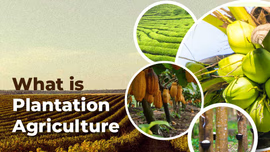Soil Salinity in India: Causes, Prevention and Solutions

Soil Salinity is a growing issue in India which is a major factor for the loss of productivity of cultivated soils. Primarily caused by natural factors and human activities such as over-irrigation, excessive use of fertilizer, improper drainage and poor crop management. It threatens crop productivity and soil health on a massive scale. For this reason, it is important to implement strategies to protect our farmland and ensure sustainable agriculture for the future. In this blog, we will learn more about soil salinity, the factors that contribute to it, and ways to prevent it.
Table of Contents
- What is “Soil Salinity”?
- What are the Major Causes of Soil Salinity?
- How to Identify if Soil has become Saline?
- How to Prevent Soil Salinization?
- Major States in India Affected by Soil Salinity
- What is the Difference Between Saline Soil and Sodic Soil?
What is ‘Soil Salinity’?
The term "salinity" refers to the concentration of salt in soil or water. A high concentration of salt in the soil can frequently result in 'soil salinity,' which harms the soil's alkaline level and crop production. Fertilizers used in farming are usually made up of salts like potassium, calcium magnesium, chloride, and ammonium sulfate. When these fertilizers are spread on fields in an excessive quantity it could lead to soil salinity. Salt-affected soils occur in arid and semi-arid environments where evaporation occurs much faster than precipitation.
There are two types of soil salinity – primary soil salinity and secondary soil salinity. The primary soil salinity is mainly caused by the presence of naturally occurring salt. Whereas the secondary soil salinity develops because of the excessive use of fertilizers used on agricultural land or poor water management.
In India, approximately 6.73 million hectares of land are affected by Soil Salinity. This constitutes around 2.1% of the country's total geographical area.
What are the Major Causes of Soil Salinity?
Natural (primary) and human-induced (secondary) are the two major causes of soil salinity. Lets discuss them in more detail.
Natural Causes of Soil Salinity (Primary): Soil develops from rocks and minerals that naturally contain high levels of salts (e.g., gypsum, halite). Weathering of such parent materials can release salt into the soil. Low rainfall is another reason of soil salinity. In coastal regions, excessive groundwater pumping and rising sea levels can result in the mixing of seawater with the freshwater supply. The seawater eventually makes its way to farmland, where, through evaporation, it is transformed into soil.
Human Induced Causes of Soil Salinity (Secondary): Poor irrigation practices, excess water from water logging or irrigation without proper drainage system are the examples of human induced causes of salinity. Farm fertilizers contain high levels of salt content such as Potassium and magnesium. When used in excess without a proper schedule, it can lead to increase of the salt concentration in soil.
How to Identify if Soil has become Saline?
- Look for Signs on the Soil Surface: If there is a white crust forming on the soil surface it might indicate that the soil has a high saline level. These white crusts (salt particles) form when water evaporates and leaves behind a film of dissolved salt.
- Plant Health Indicators: Look for any signs of stress such as yellowing, browning, or burning of leaf edges. If you notice a drop in crop performance, growth, or productivity, saline soil might be one of the reasons affecting plant health.
- Soil Testing: A common method to assess soil salinity is by measuring its electrical conductivity. High EC levels typically indicate a high concentration of salts. Send your soil sample to a lab for detailed analysis that can provide information on salt concentrations and specific ions (like sodium, chloride, and sulfate).
- Check for Water Quality: If you’re using groundwater or surface water for irrigation, testing the water for salt content can also help determine if salts are being introduced to your soil.
How to Prevent Soil Salinization?
Proper irrigation practices, improved drainage, crop management, soil conditioning, etc. are some of the preventive measures of soil salinity. Let’s have a look at each point:
Better Irrigation Practices
- Check the quality of Water: Whenever irrigating crops make sure to use water with low salt concentration to prevent additional salt accumulation.
- Drip Irrigation: This form of irrigation applies water directly to the root zone which helps reduce evaporation and any form of salt buildup on the soil surface.
- Schedule your Irrigations: Apply water in amounts that meet crop needs without causing waterlogging or over-irrigation.
- Leaching: Leaching means the removal of salt below the solum of the soil. Leaching with high-quality water is the only practical method for removing excess salt from the soil. In cases where salt has already accumulated, add more water on a regular basis to flush them below the root zone.
Improved Drainage System
- Upgrade Drainage Systems: Effective drainage systems help remove excess water, lowering the water table and minimizing salt accumulation.
- Surface Drainage: Proper land grading and contouring can direct excess water away from fields, preventing salt from being drawn upward.
Mechanical/Physical Methods to Combat Soil Salinity
- Scrap the Salt: If white salt concentrations are apparent, remove them immediately from the field using household instruments like khurpi.
- Trenching Method: The procedure involves excavating tiny pits in the field and transferring subsoil to the surface to bury saline soil.
- Flooding of Salt: The affected soil is first flooded with high-quality, salt-free water, then the dissolved salts are flushed down drainage channels. Repeating this method improves results by lowering surface layer salt concentrations.
Soil Conditioning
- Gypsum Application: Gypsum (calcium sulfate) can help replace salt on soil particles, improving soil structure and helping to leach excess salts.
- Organic Matter: Add organic matter to improve soil structure, enhance water infiltration, and increase microbial activity, which can help break down salt-affected compounds.
- Mulching: Organic or synthetic mulches reduce evaporation from the soil surface, limiting the upward movement and concentration of salts.
Crop Management
- Salt-Tolerant Crops: Select crops that can tolerate higher salinity levels. Crop rotation with salt-tolerant species can also help manage soil salinity.
- Cover Crops: Planting cover crops can help reduce evaporation, maintain soil structure, and improve overall soil health.
Monitoring and Early Detection
- Regular Soil Testing: Regularly conduct soil tests that include electrical conductivity (EC) measurements, to monitor salt levels.
- Visual Inspections: Watch for signs such as salt crusts on the soil surface or plant stress symptoms (e.g., stunted growth, and leaf burn), which can indicate emerging salinity issues.
Major States in India Affected by Soil Salinity
According to a report from the Central Soil Salinity Research Institute (CSSRI), following are some of the Indian states highly affected by soil salinity:
|
Name of the State |
Saline Soil (ha) |
Alkali Soil (ha) |
|
Gujarat |
1218255 |
541430 |
|
Haryana |
49157 |
183399 |
|
Bihar |
47301 |
105852 |
|
Karnataka |
1307 |
148136 |
|
Maharashtra |
177093 |
422670 |
|
Rajasthan |
195571 |
179371 |
|
Uttar Pradesh |
21989 |
1346971 |
What is the Difference between Saline Soil and Sodic Soil?
|
Features |
Saline Soil |
Sodic Soil |
|
Definition |
Soil affected by high Salt concentrations (Chlorides and sulfates of sodium, calcium, and Magnesium) |
Soil with a high sodium content that affects soil structure and reduces permeability. |
|
pH level |
Neutral to Slightly Alkaline (pH< 8.5) |
Highly Alkaline (pH>8.5 to 10) |
|
Electrical Conductivity (EC) |
> 4.0 dSm-1 (Indicating high salt content) |
< 4.0 dSm-1 (Sodium disperses instead of forming salts) |
|
Soil Texture |
Loose and crumbly as salt does not affect soil structure too much. |
Poor structure, sticky when wet and hard, compact when dry |
|
Water Infiltration |
Good |
Poor |
|
Effects on Plants |
Affects plant growth through osmotic stress, reducing water absorption. |
Affects plant growth by poor aeration and waterlogging. |
Frequently Asked Questions On Soil Salinity in India: Causes, Prevention and Solutions
1. What is a good salinity level for soil?
A good salinity level for soil is below 2 dS/m.
2. Which state in India has the most saline soil?
Gujarat has the most saline soil all over India.
3. What crops grow in salty soil in India?
Many crops can grow in Saline soil such as Barley, cotton, Sugar beet, Sugarcane, Rice, Mustard, Maize, green gram, Sunflower, sesame, Linseed, Bajra etc.
4. How to detect soil salinity?
Soil Salinity can be detected by checking the Electric Conductivity of the field or the soil samples to be sent to labs for testing.
5. What is TDS in soil?
Total Dissolved Solids (TDS) measures the amount of salt or other dissolved material in the soil.
6. What is the pH of saline soil?
The pH of saline soil is usually less than 8.5 which is near to neutral pH of 7.
7. What is the difference between TDS and salinity?
Salinity is the amount of Salt/Sodium component in soil or Water. TDS is the measurement that helps measure the amount of dissolved salt in soil/water.


Related Blogs












